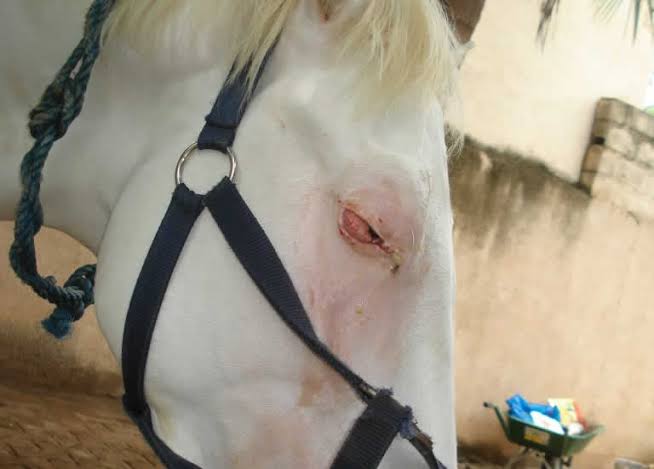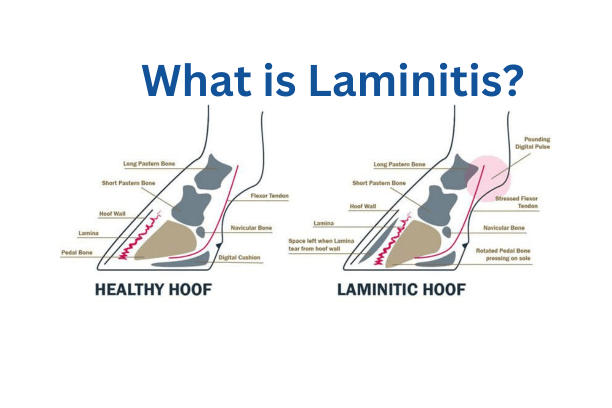
Laminitis in Horses: Understanding the Silent Threat to Hoof Health
Laminitis, a debilitating condition, refers to the inflammation of the foot’s laminae. It occurs when the epidermal laminae fail to attach to the hoof wall, causing a separation from the dermal laminae connected to the distal phalanx. This condition leads to peripheral vascular issues, such as arterio-venous shunting, reduced capillary perfusion in the foot, and ischemic necrosis.
Essentially, laminitis can be defined as the breakdown of the bond between the interior hoof wall and the distal phalanx. When the intricate structure of the inner hoof wall, responsible for suspending the distal phalanx within the hoof capsule, weakens, laminitis occurs. As a result, the weight of the horse and the forces generated during movement push the bone downwards into the hoof capsule. This damages arteries, veins, and crushes the corium of the sole and coronet, causing severe and constant pain, leading to distinct lameness.
The connection between the hoof wall and the coffin bone is crucial in preventing the horse’s body weight from pushing the coffin bone through the sole. This bond must be both robust enough to endure the forces exerted on the hoof during galloping and flexible enough to accommodate hoof wall growth. To maximize the strength of the hoof wall-coffin bone bond, this interface consists of numerous folds known as lamellae. Each lamella’s surface is further folded into numerous secondary lamellae, significantly increasing the surface area and strengthening the hoof wall-coffin bone bond. Since lamellae are composed of living cells with an extensive blood and nerve supply, various systemic diseases can contribute to the development of laminitis by affecting this critical connection.
Causes of Laminitis in Horses
- Grain Founder: Laminitis can occur when a horse consumes excessive amounts of grain, surpassing its tolerance level. This type of laminitis is often linked to gastroenteritis, with wheat and barley being the grains commonly associated. During digestion, histidine, a toxin found in grain, can be converted to histamine, which is believed to contribute to laminitis development.
- Water Founder: Ingesting a large quantity of cold water while overheated can trigger laminitis in horses.
- Grass Founder: Overgrazing on grass pastures, particularly those containing clover and alfalfa, can lead to the development of grass founder.
- Road Founder: Road founder occurs when the horse’s feet experience excessive impact from strenuous work or fast movement on hard surfaces.
- Post Parturient Laminitis: This type of laminitis occurs after foaling, usually resulting from either the retention of a portion of fetal membrane or a uterine infection without retention of fetal membranes.
- Severe Intestinal Disease: Conditions such as surgical colic or diarrhea can be associated with the onset of laminitis.
- Sepsis: Laminitis can be caused by circulating bacteria in the bloodstream, which can occur due to various factors, including pleuropneumonia, uterine infection resulting from retained placenta in post-foaling mares, and septic peritonitis (infection of the abdominal cavity).
- Exposure to Black Walnut Shavings: Contact with black walnut shavings used for bedding has the potential to trigger laminitis.
- Overweight Bearing: Excessive weight-bearing places additional stress on the horse’s hooves, contributing to the development of laminitis.
Other Contributing Factors
In addition to the specific causes mentioned above, several factors can increase the risk of laminitis in horses:
- Metabolic Disorders: Numerous metabolic disorders, often related to obesity, can heighten the likelihood of laminitis.
- Ingestion of Ergot Alkaloids: Consumption of endophyte-infested fescue grass, which contains ergot alkaloids, can contribute to the development of laminitis.
- Inactivity: Lack of physical activity, particularly when combined with obesity, can be a contributing factor.
- Sudden Exposure to Strenuous Exercise: Abruptly subjecting a horse to intense exercise without proper conditioning can potentially trigger laminitis.
- Stress: High-stress occupations or environments, long-distance transportation, and prolonged hospitalization can increase the susceptibility to laminitis.
- Poor Hoof Conformation or Improper Trimming/Shoeing: Issues such as improper hoof conformation, inadequate trimming, or incorrect shoeing techniques can play a role in the development of laminitis in horses.
Clinical Signs of Acute and Chronic Laminitis in Horses
Acute Laminitis
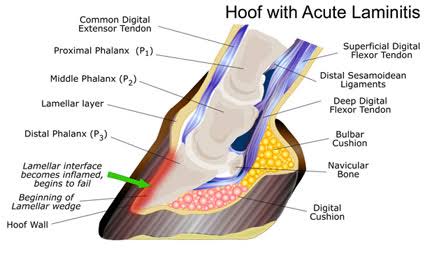
- Lameness: Horses with acute laminitis exhibit signs of lameness, showing reluctance to bear weight on their affected feet.
- Increased Temperature: The affected hooves may feel warmer to the touch compared to normal temperature.
- Elevated Digital Pulses: Digital pulses in the affected limbs become stronger and more noticeable.
- Painful Response to Hoof Testers: Application of pressure with hoof testers elicits a painful reaction from the horse.
- Predominance in Forelimbs: Acute laminitis most commonly affects the forelimbs, possibly due to the greater weight borne by them. However, hind limbs can also be involved.
- Altered Gait: Horses with laminitis display a characteristic gait with stiff limb movement while maintaining an anterior placement of both fore- and hind limbs. Horses with all four feet affected may exhibit a more normal stance or appear “camped out” with forelimbs positioned more anteriorly and hind limbs positioned more posteriorly.
- Heat Presence: Increased heat can be detected throughout the sole, hoof wall, and coronary band of the affected hooves.
- Anxiety: Horses suffering from acute laminitis often exhibit signs of restlessness and anxiety.
- Muscular Trembling: Severe pain can lead to trembling of the horse’s musculature.
- Increased Respiration: Horses may show an elevation in respiratory rate due to the pain and stress associated with laminitis.
Chronic Laminitis
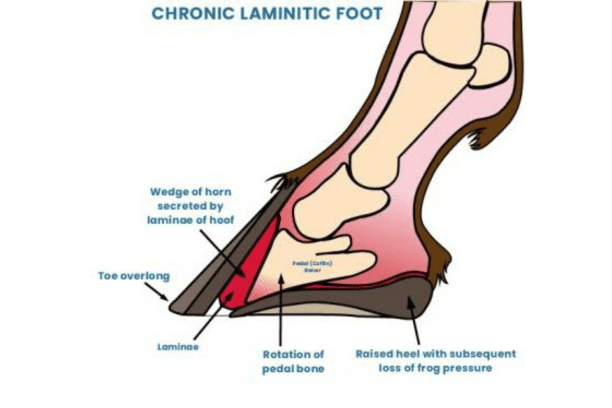
- Rotated Third Phalanx: Chronic laminitis can result in the rotation of the third phalanx (coffin bone) within the hoof.
- Separation of Sensitive Laminae: The sensitive laminae, which connect the hoof wall to the coffin bone, can become separated.
- Pull of the Deep Flexor Tendon: The deep flexor tendon exerts a pull on the semilunar crest of the third phalanx, contributing to the abnormal positioning of the bone.
- Exaggerated Heel Landing: Horses with chronic laminitis tend to land on their heels in an exaggerated motion.
- Dropped and Flat Sole: The sole of the hoof appears dropped and flattened in chronic laminitis cases.
- Rapid Hoof Wall Growth: The hoof wall exhibits accelerated growth.
- Long Toe: Affected hooves may develop a long toe that curls up at the end.
- Heavy Ring Formation: The hoof wall can display thick and pronounced rings.
- Seedy Toe: Chronic laminitis can lead to the development of seedy toe, characterized by separation and infection of the white line.
- White Line Separation: Significant separation of the white line may occur, allowing for potential infection to penetrate the sensitive laminae.
- Sole Bleeding: Increased vascularity associated with laminitis may cause bleeding in the sole.
Prevention of Laminitis
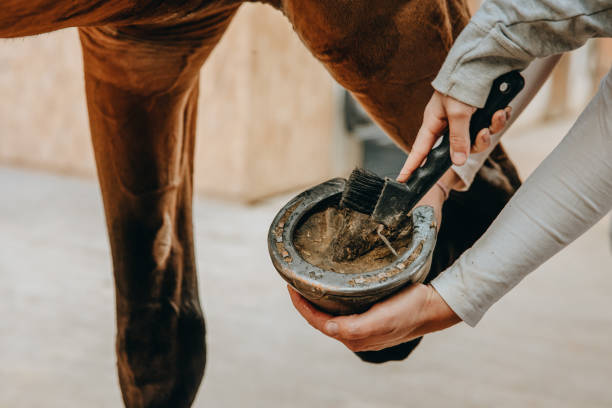
To prevent laminitis in horses and ponies, it is important to take the following measures:
- Regular Hoof Care: Ensure that your horse receives regular hoof care from a reputable and skilled farrier. Regular trimming and proper shoeing help maintain correct hoof balance and promote healthy hoof function. This can significantly reduce the risk of laminitis caused by mechanical factors or poor hoof conformation.
- Balanced Ration: Ensure that your horse or pony receives a well-balanced diet suitable for their specific type, age, and level of activity. Providing the right nutrients in appropriate quantities is crucial for maintaining overall health and minimizing the risk of laminitis.
- Pasture Management: Limit the access of your equine to lush pastures, especially during the wet spring months. These pastures tend to be high in sugar content, which can increase the susceptibility to laminitis. Implement strategies such as grazing muzzles, strip grazing, or using dry lot areas to control and monitor the intake of rich grass.
- Prompt Veterinary Attention: If you see any sign of retained placenta in your mare after foaling or if your horse shows any symptoms of illness, seek immediate veterinary attention. Delaying treatment can exacerbate the risk of developing laminitis. Early intervention and appropriate medical care can help prevent complications and reduce the likelihood of laminitis onset.
Conclusion
Laminitis is a condition in horses that requires careful attention and proactive measures from horse owners and caretakers. By understanding the causes, recognizing the clinical signs, and implementing preventive strategies, the risk of laminitis can be significantly reduced. By prioritizing the overall health and well-being of horses, we can work towards minimizing the impact of laminitis and promoting their soundness and longevity.






